Flying with a baby can feel like an uphill battle, especially on long-haul flights. Babies are unpredictable—one moment, they’re cooing, and the next, they’re restless and crying. The secret to a smooth trip lies in careful planning, creative thinking, and an arsenal of distractions to keep your little one entertained.
This guide dives deep into how to keep baby preoccupied in long flight, covering everything from packing essentials to managing meltdowns. Let’s help you turn those hours in the air into a manageable (and maybe even enjoyable) experience.
Introduction
Are you feeling a little anxious about your upcoming flight with your baby? You’re not alone. Many parents worry about keeping their baby happy and preoccupied during long flights. The truth is that preparation and a touch of creativity go a long way toward making air travel with your little one more manageable.
In this guide, you’ll discover everything you need to know about how to keep baby preoccupied in long flight—from packing smartly to entertaining them in creative ways. So buckle up, and let’s make your journey as smooth as possible!
How to Keep Baby Preoccupied in Long Flight
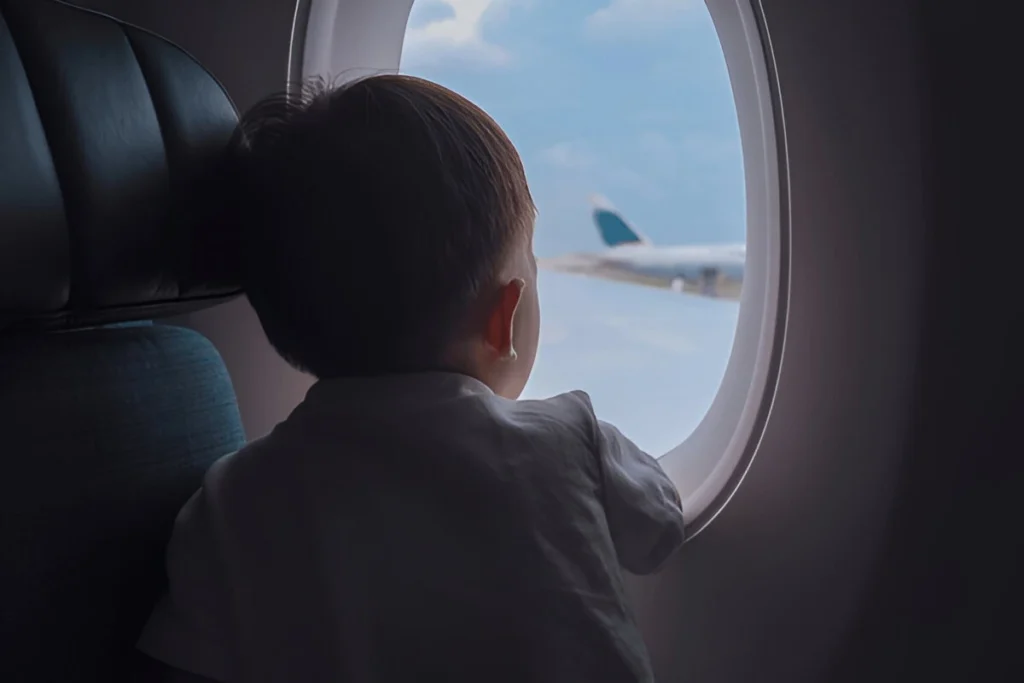
How exactly do you keep a baby engaged and content during hours of air travel? The answer lies in a combination of entertainment, comfort, and routine maintenance. Babies thrive on familiarity and stimulation, so your job is to provide both while navigating the challenges of an unfamiliar environment.
This guide will walk you through tried-and-true strategies that have worked for countless parents. Whether it’s packing suitable toys, planning strategic naps, or staying calm during meltdowns, you’ll have the tools you need to keep your baby happy in the air.
Why Do Babies Get Fussy on Flights?
Causes of Baby Fussiness
Air travel introduces a host of new sensations and challenges for babies, such as:
- Ear Pressure Changes
- During takeoff and landing, the rapid changes in cabin pressure can make babies uncomfortable. Their smaller ear canals are more sensitive, leading to ear pain.
- Overstimulation
- Airports and airplanes are filled with unfamiliar sights, sounds, and smells. This sensory overload can overwhelm babies, making them restless.
- Confinement
- Babies love to move and explore. Being confined to a small seat or bassinet can frustrate them, especially as the hours drag on.
- Interrupted Routines
- Changes in sleeping, feeding, and play schedules can throw your baby off balance, leading to fussiness.
Overcoming Common Triggers
Here are actionable tips for managing common triggers:
- Easing Ear Pressure: Offer a pacifier, bottle, or breastfeeding during takeoff and landing. The sucking motion helps equalize ear pressure.
- Reducing Overstimulation: Carry a soft, familiar toy or blanket to comfort your baby and block out distractions.
- Addressing Restlessness: Rotate activities every 15–20 minutes to keep them engaged.
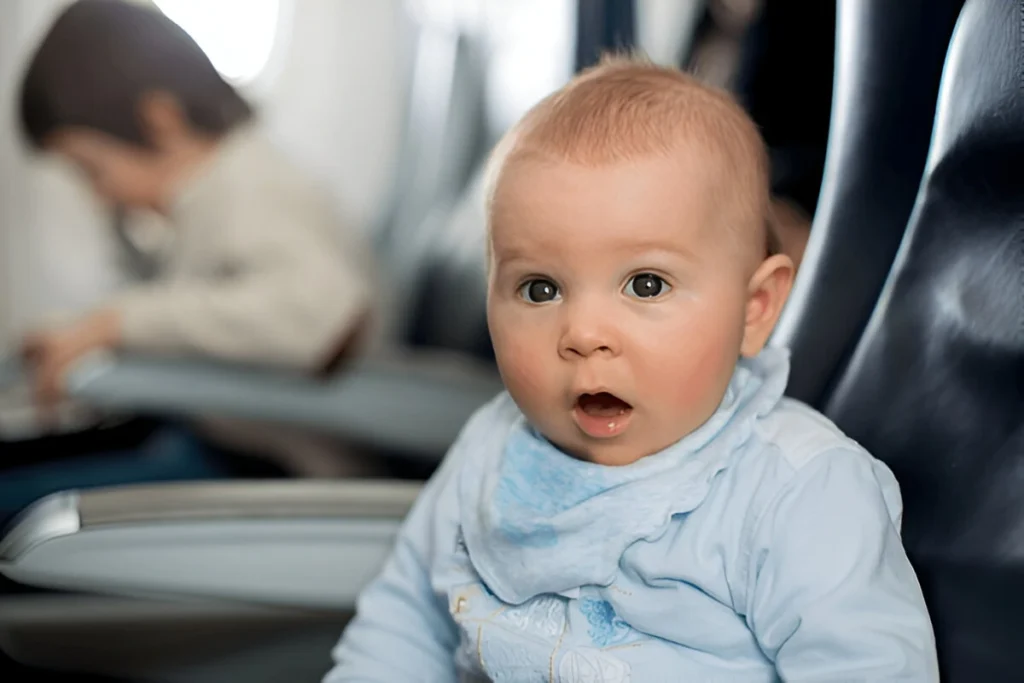
Plan Ahead for a Smooth Journey
Preparation is your best friend when traveling with a baby. A few proactive steps can save you a lot of stress later.
Researching Baby-Friendly Airlines
Not all airlines are created equal when it comes to accommodating families. Look for airlines that offer:
- Bassinet options for long-haul flights.
- Family boarding or priority seating.
- Onboard amenities like diaper-changing tables.
Choosing the Perfect Seats
- Bulkhead Seats: These provide extra legroom and space for bassinets.
- Aisle Seats: If you’re flying alone, an aisle seat gives you easier access to the bathroom for diaper changes.
- Avoid Noisy Areas: Try to avoid sitting near the galley or restrooms, which can be busy and loud.
Packing Essentials for Flying with a Baby
Packing the right items can mean the difference between a smooth flight and a stressful one. Use this checklist:
| Category | Must-Have Items |
|---|---|
| Diapering | Diapers, wipes, disposable changing pads, diaper cream, small trash bags |
| Feeding | Bottles, pre-measured formula, bibs, sippy cups, snacks |
| Entertainment | Soft toys, board books, teething rings, stacking cups |
| Comfort | Baby blanket, pacifier, noise-canceling headphones |
| Medical | Baby-safe pain relievers, thermometer, band-aids |
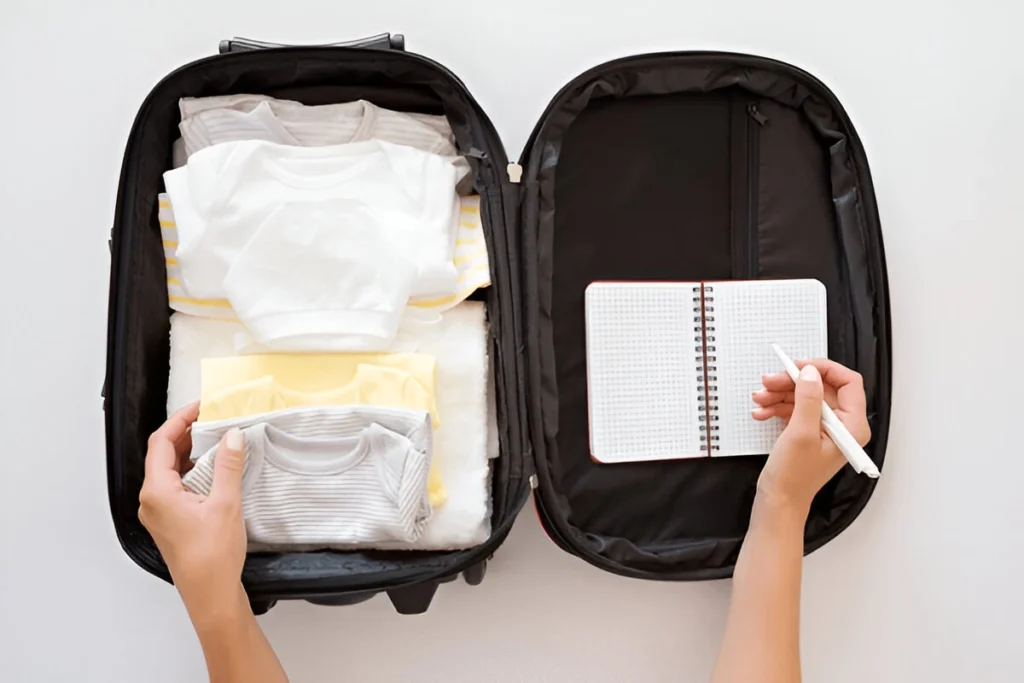
Pack these in a well-organized diaper bag, and keep frequently used items easily accessible.
Adjusting Your Baby’s Schedule for Travel
Napping Strategies
If your flight overlaps with nap time, try these tips:
- Use a travel pillow or bassinet to support their sleep.
- Block out distractions with a nursing cover or blanket draped over the seat.
Feeding Adjustments Before the Flight
- Feed your baby before heading to the airport to avoid hunger-related meltdowns.
- Plan to feed during takeoff and landing to minimize ear pain.
How to Entertain Your Baby on a Long Flight
Babies get bored quickly, so you’ll need a variety of distractions.
Toy Recommendations for Babies
- Interactive Cloth Books: Lightweight and full of textures to explore.
- Stacking Cups: Great for creative, mess-free play.
- Teething Toys: Provide comfort and entertainment.
Creative DIY Activities
- Peek-a-Boo with a Blanket: A timeless classic that never fails.
- Surprise Bag: Fill a bag with safe household items for your baby to explore.
Feeding Tips and Snack Ideas During the Flight
A full tummy keeps a baby happy.
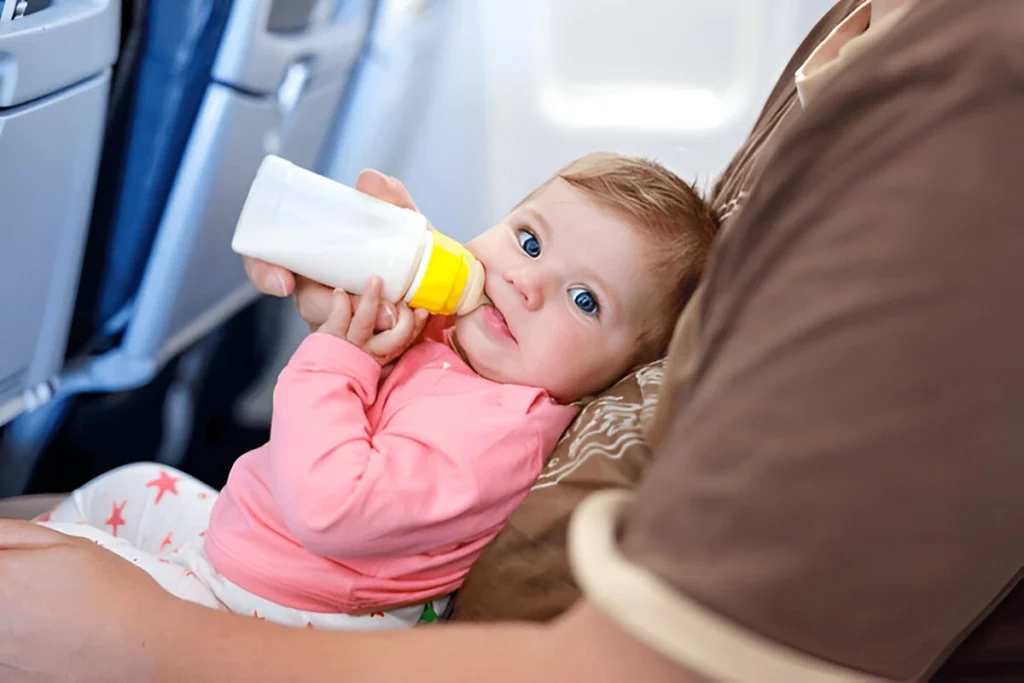
The Best Baby-Friendly Snacks to Pack
- Baby puffs or rice crackers (easy to grab and eat).
- Soft fruits like bananas or peeled apples.
- Yogurt pouches for mess-free feeding.
Breastfeeding and Bottle-Feeding Tips
- If breastfeeding, wear a nursing-friendly top and use a scarf or cover for privacy.
- For formula-fed babies, pre-measure formula and bring a thermos of warm water.
Handling Diaper Changes at 35,000 Feet
Changing a diaper in the cramped airplane bathroom can be tricky. Here’s how to make it easier:
- Use the bathroom’s fold-down changing table.
- Bring a disposable changing pad to place on the surface.
- Pack diapers, wipes, and cream in a small, separate pouch for quick access.
Managing Sleep and Comfort on the Plane
Getting your baby to sleep during a flight can feel like an uphill battle, especially when surrounded by noise and distractions. However, creating a familiar and soothing environment can help your little one drift off.
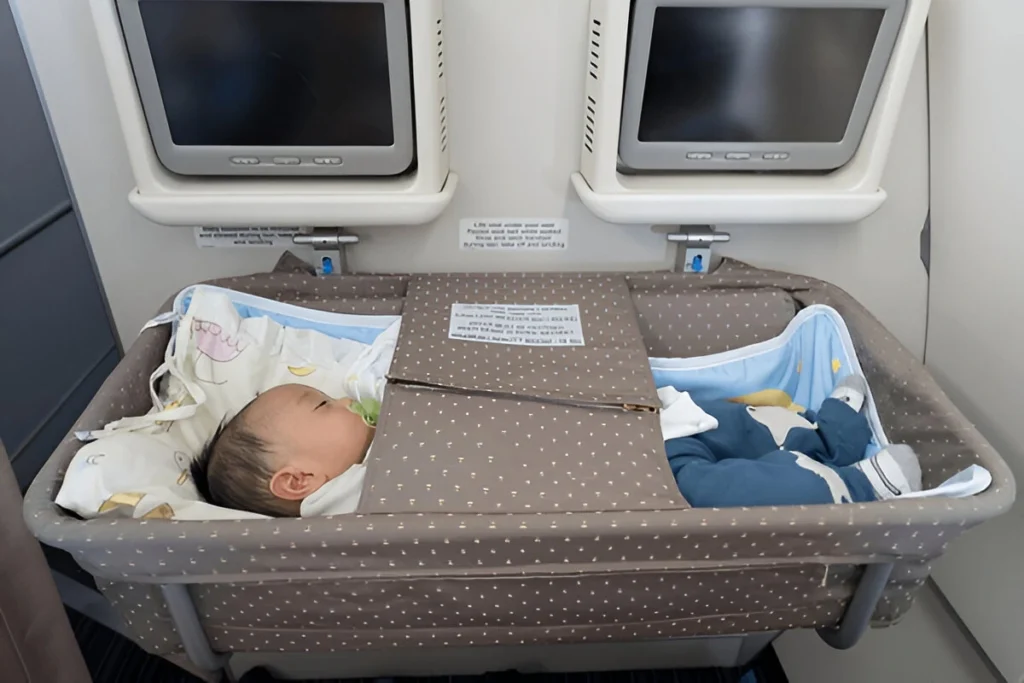
Creating a Cozy Sleep Environment
- Use Familiar Items: Bring along your baby’s favorite blanket, stuffed toy, or sleep sack to mimic their usual sleeping setup.
- Consider a Travel Pillow: For older babies, a small neck pillow can provide extra support.
- Dim the Lights: Use a nursing cover or muslin cloth to block out bright cabin lights.
Dealing with Interruptions to Sleep
- If your baby wakes up due to turbulence or noise, soothe them with gentle rocking or a soft lullaby.
- Adjust your expectations—airplane sleep may not match the quality of home sleep, and that’s okay!
How to Calm a Crying Baby on a Plane
Crying is a natural response for babies, especially when they’re in an unfamiliar environment. Here’s how to handle it effectively:
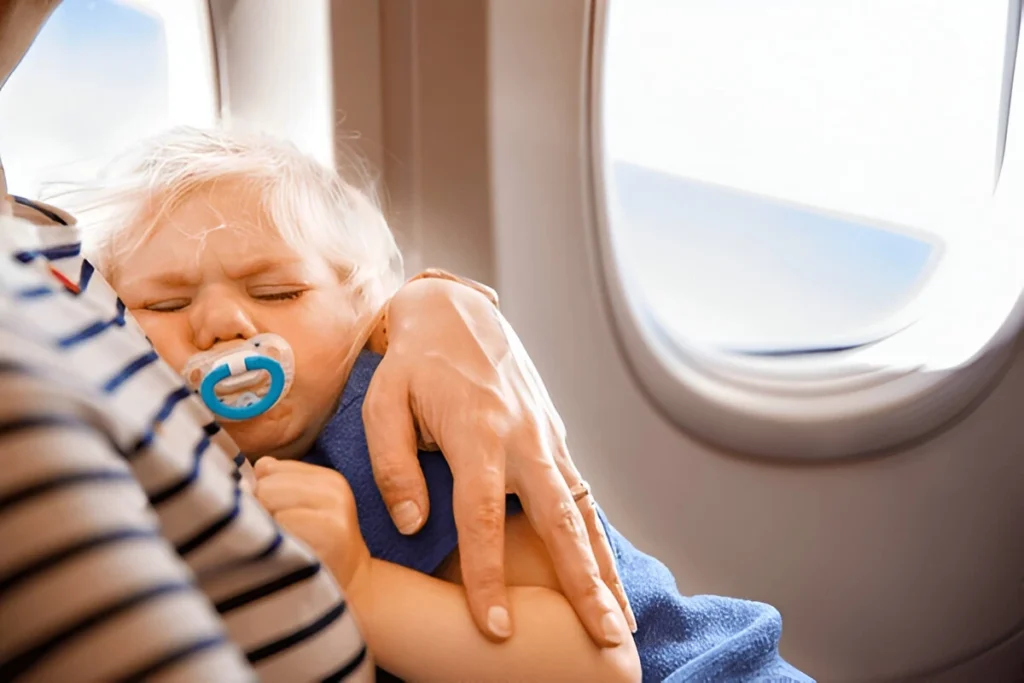
Effective Soothing Techniques
- Walk Around: When it’s safe to do so, walk up and down the aisle with your baby to soothe them.
- Skin-to-Skin Contact: Holding your baby close can offer comfort and reassurance.
- White Noise: The hum of the airplane itself can act as white noise, but if that doesn’t work, apps or portable white noise machines can help.
Dealing with Overstimulation
- Reduce distractions by turning your baby away from busy areas of the plane.
- Engage them with a quiet activity, like flipping through a small photo album of family members.
Traveling Respectfully Around Fellow Passengers
While your primary focus is your baby, it’s also important to consider the experience of those around you. Here’s how to strike a balance:
Silent Entertainment Ideas
- Use quiet toys like stacking rings or cloth books instead of anything that rattles or squeaks.
- Offer your baby screen time with muted audio or child-safe headphones.
Handling Negative Reactions Gracefully
- Acknowledge and apologize if your baby’s crying disturbs someone nearby. A polite “Thanks for understanding, babies can be unpredictable!” can go a long way.
- Remember that most passengers have been in your shoes or know someone who has—they’ll likely be more understanding than you expect.
How to Handle Unexpected Challenges While Traveling
Even with careful planning, surprises can pop up. Here’s how to stay adaptable:
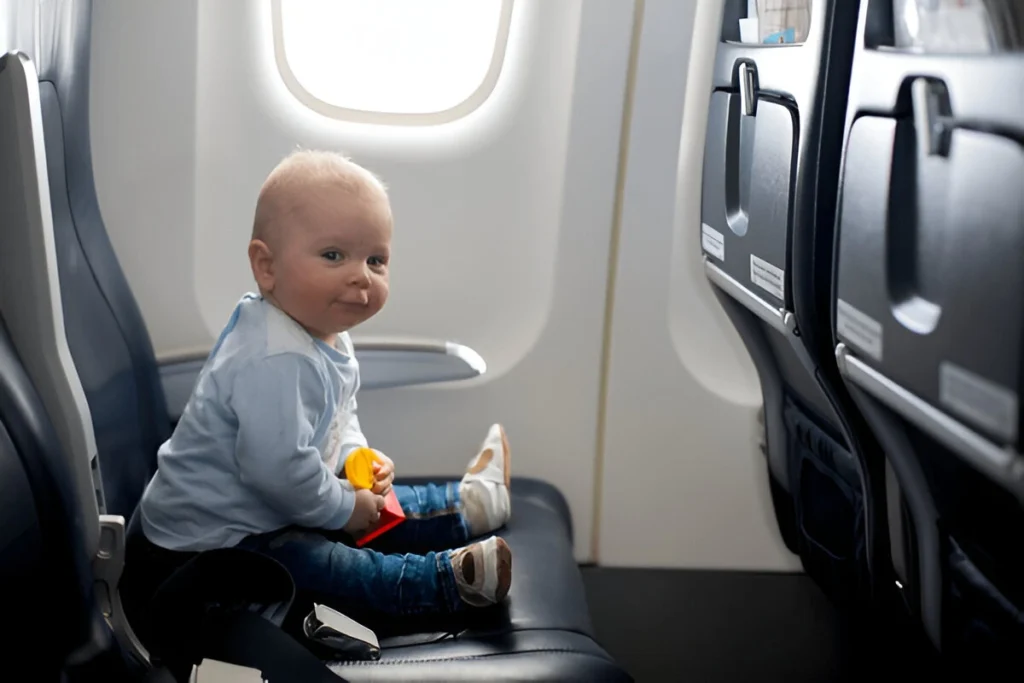
What to Do During Delays or Layovers
- Use the Time Wisely: Layovers are great opportunities for babies to crawl, walk, or stretch. Find a quiet corner in the terminal for some playtime.
- Pack Extra Supplies: Always pack more diapers, snacks, and formula than you think you’ll need in case of delays.
Traveling Alone with a Baby
Flying solo with a baby? Here are some pro tips:
- Ask for Help: Don’t hesitate to ask flight attendants or fellow passengers for assistance, especially when boarding or storing luggage.
- Streamline Your Bags: Use a backpack-style diaper bag to keep your hands free.
FAQs About Flying with Babies
- What’s the best seat for flying with a baby?
- The bulkhead row is ideal for parents traveling with infants because it often accommodates bassinets and has extra legroom.
- Can I bring baby food and formula on the plane?
- Yes, most airlines allow baby food, formula, and breast milk in reasonable quantities, even exceeding liquid limits. Check your airline’s specific policies before traveling.
- How do I manage my baby’s ears during takeoff and landing?
- Encourage your baby to suck on a pacifier, bottle, or breastfeed to relieve ear pressure caused by cabin altitude changes.
- What are the must-haves in a carry-on for a baby?
- Diapers, wipes, changing pads, extra clothes, feeding supplies, a blanket, pacifiers, toys, and any necessary medications are all essentials.
- Is it better to fly during the day or night with a baby?
- This depends on your baby’s routine. Night flights might align with their sleep schedule, while day flights offer more opportunities to keep them entertained.
- What should I do if my baby won’t stop crying?
- Stay calm and patient. Try soothing techniques like walking, rocking, or feeding. If nothing works, remind yourself (and others) that babies cry—it’s normal!
Conclusion
Flying with a baby doesn’t have to be a nightmare. With the proper preparation, strategies, and mindset, you can make the journey smoother for both you and your little one. This guide on how to keep baby preoccupied in long flight offers everything you need—from packing smart to handling mid-flight meltdowns.
Remember, every trip is a learning experience. By staying adaptable and prepared, you’ll gain confidence with every flight. Bon voyage, and enjoy the adventure!
